on Mercedes Batteries, Cost & Quality and Lots of Electrics
on a new Mercedes battery plant, why cost-to-own is an important metric, what Volvo and Starbucks are doing, the importance of architecture (as in buildings, not vehicles), and some interesting new vehicles
Mercedes Making Batteries in Alabama
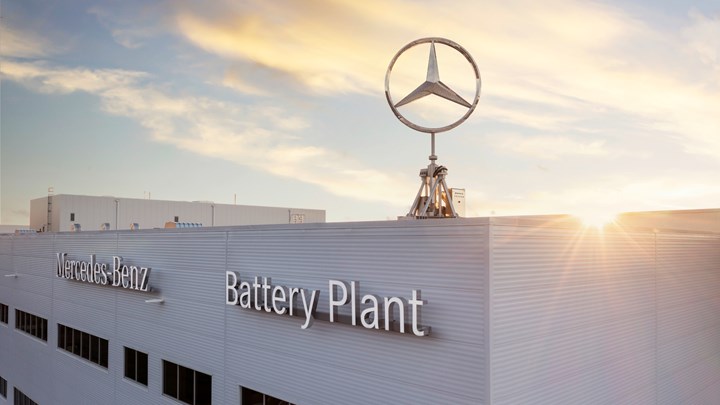
A new addition to the Mercedes global network of battery plants—this one in Alabama. (Image: Mercedes-Benz)
Mercedes has been building SUVs in Tuscaloosa, Alabama, since 1997.
Now the company is preparing to add the EQS and EQE SUVs to that operation--which, incidentally, produced some 260,000 vehicles in 2021, as it seems that people can’t get enough of high-end SUVs
As for the EQS and the EQE: Both are electric vehicles.
And because they need batteries. . .
Mercedes has opened a lithium-ion battery plant in nearby Bibb County to supply the EV SUVs. The supply chain between the plants is short: about 35 miles.
The battery cell chemistry Mercedes is nickel, cobalt and manganese in an 8:1:1 ratio, with the cobalt content being about 10%.
(Why is that important? Because generally, cobalt has been particularly expensive, driving up the cost of batteries. Now, pretty much all of the elements of an EV battery are climbing faster than the price of a gallon of gas.)
The new plant is part of a more than one-billion euro investment to create a global battery network, with battery plants in Kamenz, Germany, Beijing China, Bangkok Thailand, Jawor Poland and Stuttgart, Germany.
Made in the USA
Ola Källenius, Chairman of the Board of Management of Mercedes-Benz Group AG:
"The opening of our new battery plant in Alabama is a major milestone on our way to going all-electric. With our comprehensive approach including a local cell sourcing and recycling strategy, we underline the importance of the U.S., where Mercedes-Benz has been successful for decades. We're proud to create new, future-proof jobs to build all-electric SUVs ‘Made in the USA' at a plant that is such an established part of our production family since 25 years."
It is worth noting that about two-thirds of the output of the Tuscaloosa plant are exported.
Who knew that the company that is so associated with Germany is one of the leading automotive exporters from the U.S.?
Numbers:
The battery plant will employ approximately 600 people.
The production line is 984 feet long and has more than 70 workstations.
///
Quality and Cost
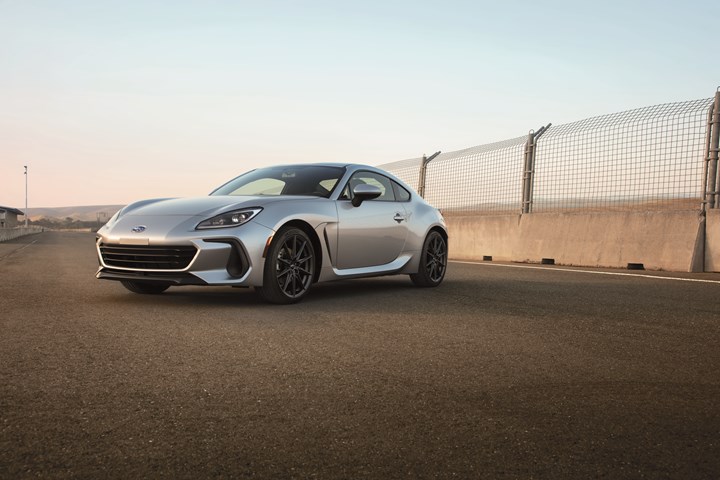
Subaru BRZ: quick and can save one money over time. (Image: Subaru)
There are certainly many definitions of quality, from making something to a minimum standard or better at the bottom to the highest degree of excellence of a given product.
And while the Kelley Blue Book “5-Year Cost to Own Awards” is a guide for consumers when they’re out shopping, arguably it is an interesting measure of quality.
What is measured is self-explanatory in the name of the award.
The calculation takes into account metrics including the price of the vehicle, fuel, maintenance, insurance, fees and depreciation.
The build quality has a lot to do with the price of the vehicle, how much maintenance it is likely to need, and the cost of repair, which is a consideration for insurance cost calculations.
Fuel goes to the efficiency of the powertrain engineering. And while depreciation takes a variety of factors into account, there is a correlation between the quality of a vehicle and whether it holds its value over a period of time.
Here is the list of the ’22 “5-Year Cost to Own Award” winners with the amount saved compared with the segment average:
- Compact Car: Toyota Corolla (-$2,323)
- Midsize Car: Honda Accord (-$893)
- Full-size Car: Toyota Avalon (-$3,570)
- Entry-level Luxury Car: Acura ILX (-$14,684)
- Luxury Car: Volvo S90 (-$16,145)
- Sports Car: Subaru BRZ (-$21,739)
- Midsize SUV – 2-Row: Subaru Outback (-$6,730)
- Midsize SUV– 3-Row: Subaru Ascent (-$4,121)
- Hybrid Vehicle: Toyota Corolla Hybrid (-$10,303)
- Electric Vehicle: Nissan LEAF (-$13,258)
- Full-size SUV: Nissan Armada (-$6,822)
- Luxury Subcompact SUV: Lexus UX (-$3,224)
- Luxury Compact SUV: Lexus NX (-$6,219)
- Luxury Midsize SUV – 2-Row: Lexus RX (-$12,156)
- Luxury Midsize SUV – 3-Row: Acura MDX (-$7,193)
- Luxury Full-size SUV: Lexus LX (-$12,698)
- Off-road SUV: Ford Bronco (-$3,059)
- Subcompact SUV: Hyundai Venue (-$6,982)
- Compact SUV: Subaru Forester (-$1,957)
- Midsize Pickup Truck: Ford Ranger (-$3,321)
- Full-size Pickup Truck: Toyota Tundra (-$4,669)
- Minivan: Toyota Sienna (-$5,354)
- Luxury Electric Vehicle: Tesla Model 3 (-$16,411)
Why are there cases with a whopping save?
Well, part of it has to do with the segment the vehicle competes in, according to a Cox Automotive analyst. For example, the Subaru BRZ is in a segment that encompasses vehicles that cost from ~$30,000 (where the BRZ is, as it has a starting MSRP of $27,995) to $170,000. Those high-priced vehicles skew the numbers (remember: purchase price is part of the analysis).
Of course, those opting for a $170,000 vehicle are probably not too concerned with the 5-Year Cost to Own Award. . . .
///
Charges & Coffee
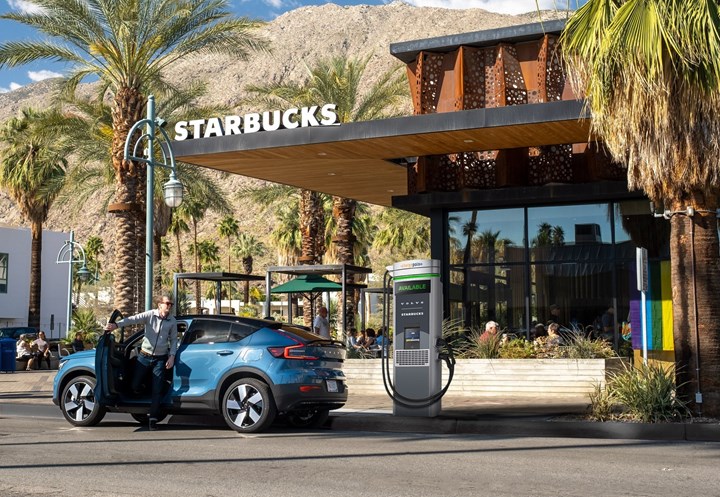
When you or your vehicle need a proverbial jolt. (Image: Volvo)
“There are 116,641 convenience stores selling fuel in the United States, and these retailers sell about 80% of all the fuel purchased in the country,” according to NACS, The Association for Convenience & Fuel Retailing.
More: “To counter slim profit margins for fuels sales, store operators seek to drive profits by growing their in-store sales, especially on food and beverages. Virtually any item inside the store can carry a healthier profit margin than a fill-up at the pump.” [emphasis added]
That’s right. That mystery meat stick and coffee that is beyond burned (which explains the array of flavored “creams”) have better margins that the gas.
Volvo Car USA and Starbucks have announced a collaboration to bring electric chargers to some of its stores located between Seattle and Denver.
There will be some 60 Volvo-branded ChargePoint DC fast chargers at about 15 locations.
The distance is 1,350 miles and the plans call for having a location about every 100 miles.
The Volvo C40 Recharge has a range of 226 miles. Its battery can be charged from 20% to 90% on a DC fast charger in about 40 minutes.
Wonder what the margin is on a kWh compared with that of an Iced Toasted Vanilla Oatmilk Shaken Espresso?
///
The Importance of Architectural Magnets
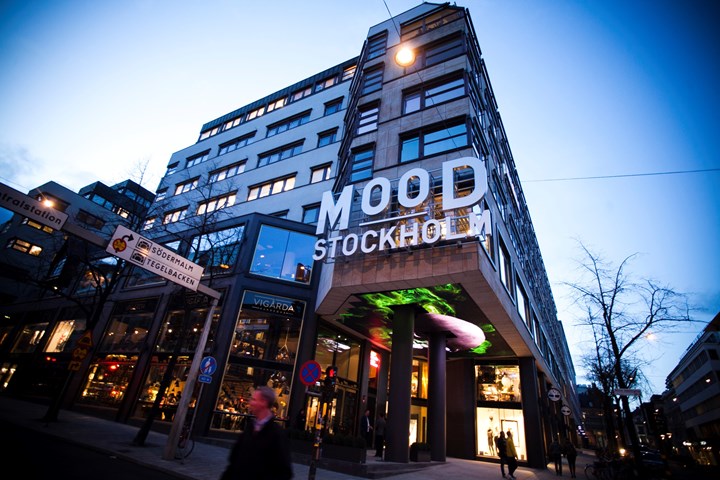
When you want to attract a different type of worker, you need to have a different kind of workplace. This is a Volvo office in downtown Stockholm. (Image: Volvo)
While on the subject of Volvo. . .
Meanwhile, over in Sweden, Volvo Cars is building out a hip venue in downtown Stockholm. It has a facility there, but this is an expansion that is meant to be a magnet to attract talented workers to its tech hub:
“Stockholm is a hot spot for tech talents, and we want to create an innovative, creative and collaborative workplace to attract people from around the world. The process has already started and we’re currently looking for new team members who can help drive our company forward.”—Hanna Fager, head of corporate functions at Volvo Cars.
Meanwhile, in Detroit. . .
You may recall that in June 2018 Ford Motor acquired the landmark Michigan Central Station in the Corktown neighborhood in Detroit.
Bill Ford, company executive chairman, said at the time, “Michigan Central Station is a place that in many ways tells the story of Detroit over the past century.
“We at Ford want to help write the next chapter, working together in Corktown with the best startups, the smartest talent, and the thinkers, engineers, and problem-solvers who see things differently – all to shape the future of mobility and transportation.”
Again, an architectural magnet.
Clearly, character is going to make a difference in attracting the kind of talent the auto industry needs.
///
Fanboys Saddened by Burgeoning Electrification

Subaru WRX STI: You can drive it like. . .somebody else owns it. (Image: Subaru)
One of the most-popular vehicles among those who like to drive fast and not just in a straight line is the Subaru WRX STI. “STI” signifies the top of the Subaru performance line.
The 2021 WRX STI has a 2.5-liter turbocharged Boxer engine that produces 310 hp and 290 lb-ft of torque, Multi-Mode Driver Controlled Center Differential (DCCD) Symmetrical All-Wheel Drive (whew!) and more.
But earlier this week Subaru put out an announcement regarding its electrification efforts that reads, in part:
“Subaru Corporation is exploring opportunities for the next generation Subaru WRX STI, including electrification. In the meantime, a next generation internal combustion engine WRX STI will not be produced based upon the new WRX platform.”
Sorry, guys.
Some day. Just not now.
///
Quickly Driving Where There Are Not Necessarily Roads
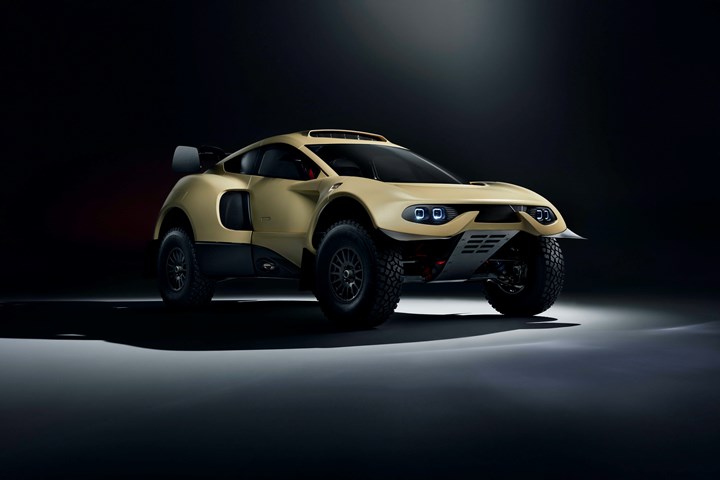
The Prodrive Hunter: When that regular off-road vehicle just won’t get it done. (Image: Prodrive)
Speaking of extreme vehicles. . .
“There are numerous hypercars on the market, however they all need good roads or even race tracks to show their performance. We identified that in certain parts of the world, particularly the Middle East, there are vast expanses still to be explored that go way beyond the access provided by asphalt roads. Therefore why not create a vehicle that gives the opportunity to explore these regions with performance way beyond that offered by any off-road vehicle before.”
That’s David Richards, chairman of Prodrive, a U.K.-based company that provides engineering services, composite materials and other resources to automotive companies. It also is engaged in motorsports.
So presumably because Richards is the chairman and because Prodrive does what it does, they answered that “why not” by bringing out the Hunter, a 592-hp, four-wheel drive, all-terrain vehicle based on a vehicle that Prodrive had developed for the Dakar Rally.
The body is carbon fiber, including recycled materials from Prodrive Composites.
There’s a high-tensile steel space frame under the skin.
The Hunter is powered by a 3.5-liter twin-turbo V6 that produces 514 lb-ft of torque.
- 0 to 62 mph: <4 seconds
- Top speed: ~185 mph
Two Touches for Those Not Driving in a Rally
- The manual transmission is replaced with a six-speed with paddle shift capability
- The interior has been designed to be more accommodating to non-race drivers by Ian Callum (who also designed the interior of the original race car version)
One Touch the Rally Car Doesn’t Have
The Hunter has a double wishbone suspension with twin adjustable dampers on each corner that offer 400 mm of travel. The setup on the race car is 350 mm.
Where Would You Drive It?
That question came to mind, so we asked.
And learned from a Prodrive spokesperson: “It is probably not a car you would use on your daily commute--although you could—but one you would use when you decide you want to venture into terrain that an ordinary car or standard 4x4 would struggle in and would have nowhere the performance of this in those conditions.”
Of course, if you happen to live somewhere off the grid and need to get groceries. . . .
///
Another EV—Delivery Van
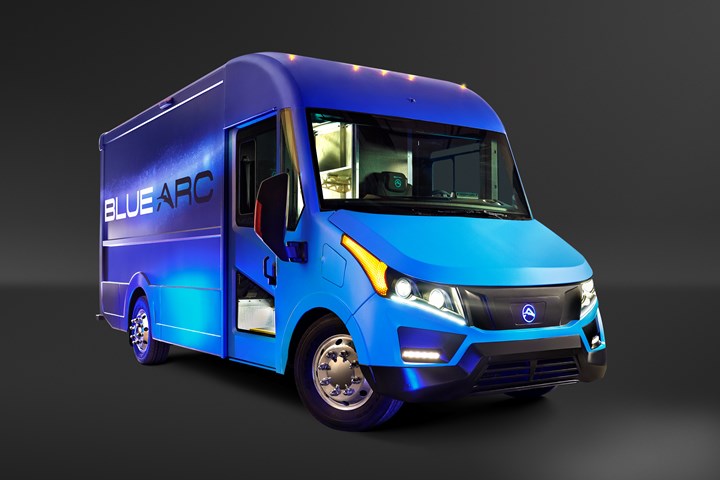
Blue Arc: An electric cargo carrier from a company with plenty of experience in that space. (Image: Shyft)
Although there’s plenty of attention given to consumer electric vehicles, the developments in the commercial space cannot be overlooked.
Consider: while Rivian may have >70K preorders for its R1T pickup and R1S SUV, it has 100,000 orders from Amazon for delivery vans.
Ford Pro has more than 10,000 orders for its E-Transit commercial vehicles.
BrightDrop is rolling out its electric vehicles to FedEx and Walmart will be getting deliveries, too, to make deliveries.
Another
Last week Blue Arc EV Solutions was announced. It has developed an electric class-3 delivery vehicle that is focused on last-mile operations.
Briefly:
- A cargo area of 635 to 800 cubic feet
- Vehicles from 14 to 18 feet in length
- Payload capacity up to 5,000 pounds
- An aluminum and composite body
- Range up to 150 miles
Notable
Blue Arc is part of The Shyft Group. In 1975, four engineers established Spartan Motors; the first product was a custom fire truck cab and chassis. 1985 saw the development of Class A diesel RV chassis. It acquired Utilimaster in 2009 and launched the Reach commercial walk-in van in 2010. And on it went in the delivery and special vehicles space.
Spartan rebranded itself as Shyft in 2020.
Its brands are Utilimaster, Royal Truck Body, DuraMag, Shyft Innovations, Strobes-R-U, Spartan RV Chassis, and Builtmore Contract Manufacturing.
In other words, a company focused on engineering and manufacturing commercial vehicles getting into the space that is undoubtedly going to grow.
Bottom Line
As Blue Arc EV Solutions vp and general manager Eric Fisher said when unveiling the truck that is expected to go into production next year, “This all-new EV chassis and delivery van offers purpose-built, customer-focused work trucks that increase speed, efficiency and impact on our customers’ bottom line.”
As a company that has been in the commercial arena for nearly 50 years, it presumably knows more than a little something about customer requirements.
///
Fuel Cell Transport: It Works
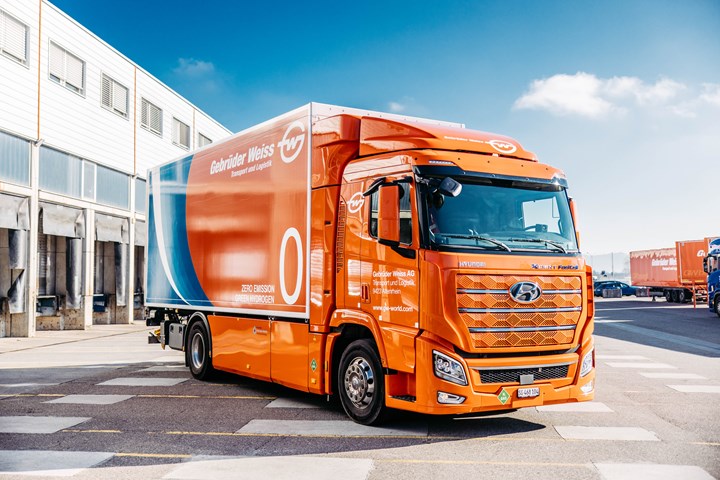
Powered by a fuel cell, this truck has handily handled routes in Switzerland this past year. (Image: Gebruber Weiss)
Gebrüder Weiss, an Austria-based logistics and transport company that was established in 1823 but has roots that go back to 1474 (the Milanese Courier Service was operated by the Spehler and Vis families; the Vis familial line is the Weiss line).
To have been around that long, it must be good at what it does.
So it is interesting to know that the company has reported on its first year operating a 36-ton Hyundai XCIENT Fuel Cell truck making runs out of a facility in Switzerland.
Why Switzerland? Because there are nine hydrogen filling stations there.
The Truck & Specs
The vehicle, which the company took on in January 2021, has been driven approximately 70,000 km (43,500 miles). The truck has a daily average distance of 430 km (267 miles).
There are 32 kg of hydrogen on board. The consumption of fuel is 7.5 kg per 100 km. Refueling takes 12 minutes. A tank is good for some 450 km (280 miles).
The truck is propelled by a 350-kW electric motor.
Positive Reaction
“The purchase was a worthwhile investment in resource-saving road freight transport. The truck is well received by the drivers and, above all, by the customers,” says Peter Waldenberger, Head of Quality and Environmental Management at Gebrüder Weiss.
Presumably, the customers are pleased that the carrier is using a truck that keeps some 80 tons of CO2 emissions per year out of the atmosphere.
As there is a build-out of refueling infrastructure Gebrüder Weiss plans to get additional trucks to operate in Austria and Southern Germany.
RELATED CONTENT
-
Ford Advancing Manufacturing
To assure that the company maintains its capabilities, relevance and leading-edge know-how in manufacturing, Ford has spent $45-million on its Advanced Manufacturing Center in Redford Township, Michigan, just west of Detroit.
-
Rage Against the Machine
There have been more than 20 reported attacks against Waymo’s self-driving fleet in Chandler, Ariz., since the company began testing the technology on public roads there two years ago.
-
Increasing Use of Structural Adhesives in Automotive
Can you glue a car together? Frank Billotto of DuPont Transportation & Industrial discusses the major role structural adhesives can play in vehicle assembly.


.jpg;width=70;height=70;mode=crop)






